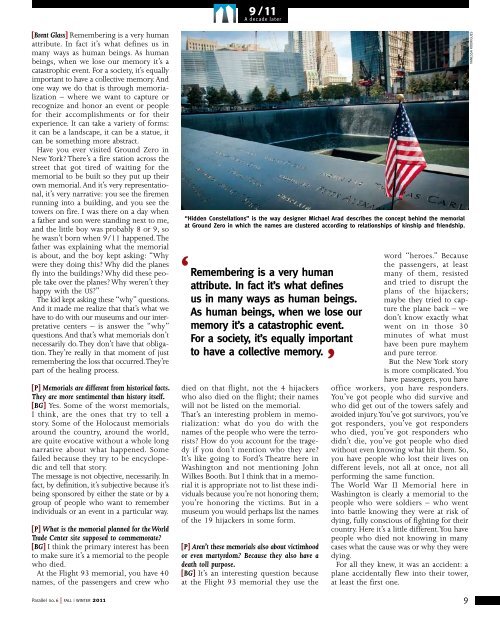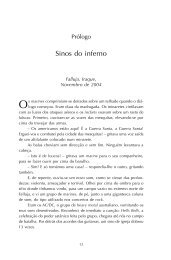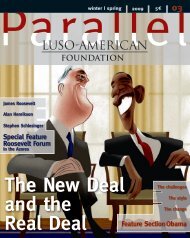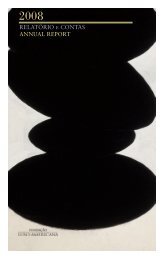A decade later - Fundação Luso-Americana
A decade later - Fundação Luso-Americana
A decade later - Fundação Luso-Americana
Create successful ePaper yourself
Turn your PDF publications into a flip-book with our unique Google optimized e-Paper software.
[Brent Glass] Remembering is a very human<br />
attribute. In fact it’s what defines us in<br />
many ways as human beings. As human<br />
beings, when we lose our memory it’s a<br />
catastrophic event. For a society, it’s equally<br />
important to have a collective memory. And<br />
one way we do that is through memorialization<br />
– where we want to capture or<br />
recognize and honor an event or people<br />
for their accomplishments or for their<br />
experience. It can take a variety of forms:<br />
it can be a landscape, it can be a statue, it<br />
can be something more abstract.<br />
Have you ever visited Ground Zero in<br />
New York? There’s a fire station across the<br />
street that got tired of waiting for the<br />
memorial to be built so they put up their<br />
own memorial. And it’s very representational,<br />
it’s very narrative: you see the firemen<br />
running into a building, and you see the<br />
towers on fire. I was there on a day when<br />
a father and son were standing next to me,<br />
and the little boy was probably 8 or 9, so<br />
he wasn’t born when 9/11 happened. The<br />
father was explaining what the memorial<br />
is about, and the boy kept asking: “Why<br />
were they doing this? Why did the planes<br />
fly into the buildings? Why did these people<br />
take over the planes? Why weren’t they<br />
happy with the US?”<br />
The kid kept asking these “why” questions.<br />
And it made me realize that that’s what we<br />
have to do with our museums and our interpretative<br />
centers – is answer the “why”<br />
questions. And that’s what memorials don’t<br />
necessarily do. They don’t have that obligation.<br />
They’re really in that moment of just<br />
remembering the loss that occurred. They’re<br />
part of the healing process.<br />
[P] Memorials are different from historical facts.<br />
They are more sentimental than history itself.<br />
[BG] Yes. Some of the worst memorials,<br />
I think, are the ones that try to tell a<br />
story. Some of the Holocaust memorials<br />
around the country, around the world,<br />
are quite evocative without a whole long<br />
narrative about what happened. Some<br />
failed because they try to be encyclopedic<br />
and tell that story.<br />
The message is not objective, necessarily. In<br />
fact, by definition, it’s subjective because it’s<br />
being sponsored by either the state or by a<br />
group of people who want to remember<br />
individuals or an event in a particular way.<br />
[P] What is the memorial planned for the World<br />
Trade Center site supposed to commemorate?<br />
[BG] I think the primary interest has been<br />
to make sure it’s a memorial to the people<br />
who died.<br />
At the Flight 93 memorial, you have 40<br />
names, of the passengers and crew who<br />
9/11<br />
A <strong>decade</strong> <strong>later</strong><br />
“Hidden constellations” is the way designer michael Arad describes the concept behind the memorial<br />
at Ground Zero in which the names are clustered according to relationships of kinship and friendship.<br />
‘ remembering is a very human<br />
attribute. in fact it’s what defines<br />
us in many ways as human beings.<br />
As human beings, when we lose our<br />
memory it’s a catastrophic event.<br />
For a society, it’s equally important<br />
to have a collective memory.<br />
’<br />
died on that flight, not the 4 hijackers<br />
who also died on the flight; their names<br />
will not be listed on the memorial.<br />
That’s an interesting problem in memorialization:<br />
what do you do with the<br />
names of the people who were the terrorists?<br />
How do you account for the tragedy<br />
if you don’t mention who they are?<br />
It’s like going to Ford’s Theatre here in<br />
Washington and not mentioning John<br />
Wilkes Booth. But I think that in a memorial<br />
it is appropriate not to list these individuals<br />
because you’re not honoring them;<br />
you’re honoring the victims. But in a<br />
museum you would perhaps list the names<br />
of the 19 hijackers in some form.<br />
[P] Aren’t these memorials also about victimhood<br />
or even martyrdom? Because they also have a<br />
death toll purpose.<br />
[BG] It’s an interesting question because<br />
at the Flight 93 memorial they use the<br />
word “heroes.” Because<br />
the passengers, at least<br />
many of them, resisted<br />
and tried to disrupt the<br />
plans of the hijackers;<br />
maybe they tried to capture<br />
the plane back – we<br />
don’t know exactly what<br />
went on in those 30<br />
minutes of what must<br />
have been pure mayhem<br />
and pure terror.<br />
But the New York story<br />
is more complicated. You<br />
have passengers, you have<br />
office workers, you have responders.<br />
You’ve got people who did survive and<br />
who did get out of the towers safely and<br />
avoided injury. You’ve got survivors, you’ve<br />
got responders, you’ve got responders<br />
who died, you’ve got responders who<br />
didn’t die, you’ve got people who died<br />
without even knowing what hit them. So,<br />
you have people who lost their lives on<br />
different levels, not all at once, not all<br />
performing the same function.<br />
The World War II Memorial here in<br />
Washington is clearly a memorial to the<br />
people who were soldiers – who went<br />
into battle knowing they were at risk of<br />
dying, fully conscious of fighting for their<br />
country. Here it’s a little different. You have<br />
people who died not knowing in many<br />
cases what the cause was or why they were<br />
dying.<br />
For all they knew, it was an accident: a<br />
plane accidentally flew into their tower,<br />
at least the first one.<br />
Parallel no. 6 | FALL | WINTER 2011 9<br />
VANESSA RODRIGUES
















